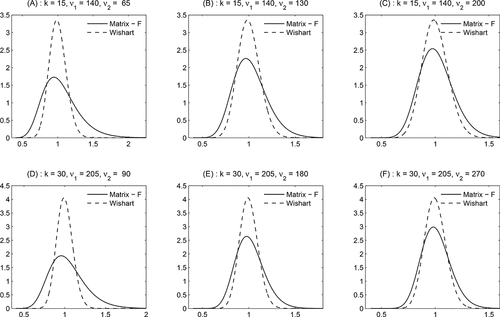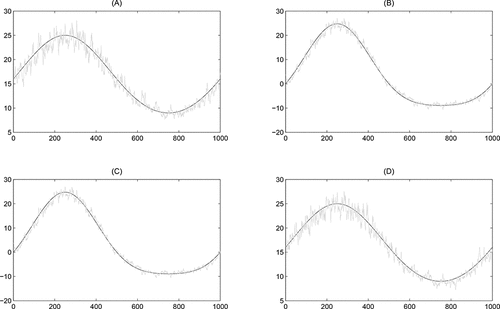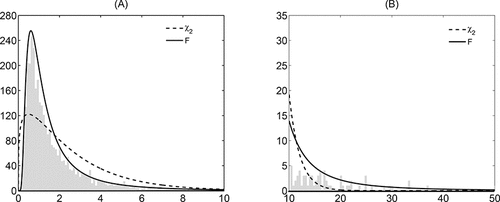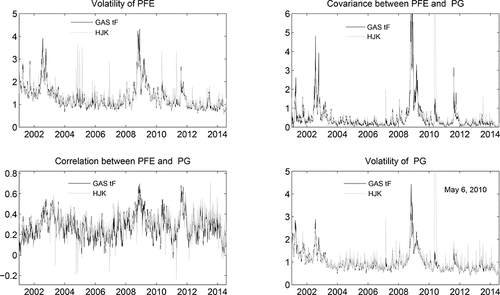Figures & data
Figure 1. The rescaled matrix-F and the Wishart distribution. This figure shows pdfs associated with a matrix-F distribution with ν1 and ν2 degrees of freedom and a Wishart distribution with ν1 degrees of freedom for a k × k matrix RCt . We plot the pdf of one of the main-diagonal entries RC ii, t (i = 1, …k), for k = 15 (upper panels) and k = 30 (lower panels) for various degrees of freedom. The solid line corresponds with the F distribution, while the dashed line represents the Wishart (χ2) distribution.

Table 1. Parameter estimations of HEAVY GAS DGP. This table shows Monte Carlo averages and standard deviations (in parentheses) of parameter estimates from simulated HEAVY GAS processes. The table reports the mean and the standard deviation in parentheses based on 1000 replications
Figure 2. Model fit for a deterministic DGP. This figure shows a realization of the simulated (co)variance process of (Equation15(15)
(15) ) (black line) with T = 1000 and the fit from the HEAVY GAS tF model (gray line). Panels A and D represent the volatilities, while panels B and C present the correlation and covariance, respectively.

Table 2. Statistical fit on stochastic DGP. This table shows Monte Carlo averages and standard deviations (in parentheses) of the RMSE defined in (Equation17(17)
(17) ) over all simulation paths of three misspecified models with respect to the true bivariate covariance matrix, which is simulated from the SV process of (Equation15
(15)
(15) ). We compare the HEAVY GAS tF model with the HJK model and the CAW model. The table reports the mean and the standard deviation of the mean in parentheses based on 1500 simulation paths
Table 3. Kolmogorov–Smirnov test on the distribution of realized variances. This table shows p-values associated with the Kolmogorov–Smirnov test on realized variances of 30 equities. The columns represent the Ticker symbol as well as p-values corresponding with the null hypothesis that RCt is χ2 or F distributed
Figure 3. The fit of the probability distribution of the realized variance of BA. This figure shows a histogram of the realized variances (RV) of Boeing over the period 2001–2014. Panel A shows the histogram for , while panel B shows the remaining part of the histogram for values of RV larger than 10. The solid and dashed curves present the best-fitting F and χ2 distribution, respectively.

Table 4. Parameter estimates, likelihoods, and information criteria. This table reports maximum likelihood parameter estimates of the HEAVY GAS (HAR) tF model, the IW-A model of Jin and Maheu (Citation2016), the HJK model of Hansen, Janus, and Koopman (Citation2016), and the CAW model of Golosnoy, Gribisch, and Liesenfeld (Citation2012), applied to daily equity returns and/or daily realized covariances. Panels A.1 and A.2 list results for two randomly chosen sets containing five different assets. Panel B considers 15 assets and panel C shows the results for the full set of 30 assets. Standard errors are provided in parentheses. We report the total likelihood and the BIC (in thousands) of the IW-A and the CAW model and the likelihood associated with the realized covariance matrix (i.e., the matrix-F and the Wishart distributions) for the GAS models. Data are observed over the period January 2, 2001 until July 31, 2014 (T = 3415 trading days)
Figure 4. Estimated volatilities and correlations. This figure depicts estimated volatilities of PFE and PG at the main diagonal and their pairwise correlations and covariances at the off-diagonal, estimated by the HEAVY GAS tF and HJK model. The black line corresponds with the HEAVY GAS tF model, while the gray line denotes the fit from the HJK model. The estimation is based on the full sample, which runs from January 2, 2001, until July 31, 2014 (3415 observations).

Table 5. Out-of-sample log-scores and ex post conditional standard deviations. This table shows the mean of log scores, defined in (Equation21(21)
(21) ) and ex post portfolio standard deviation, based on one-step ahead predictions of the covariance matrix, according to the HEAVY (HAR) GAS tF, HJK, CAW, IW-A, and the EWMA model for two pairs of five assets (panel A), one pair of 15 assets (panel B) and for all equities (panel C, k = 30). The highest (lowest) value of the predictive log-score (portfolio standard deviation) across the models are marked bold. In addition, we report HAC-based test-statistics on the difference in predictive ability (
) and portfolio standard deviation
between the HEAVY GAS HAR tF model and the other considered models. The superscripts ***, **, and * indicate significance at the 1%, 5%, and 10% level, respectively. The out-of-sample period goes from 2007 until July 2014 and contains 1914 observations
